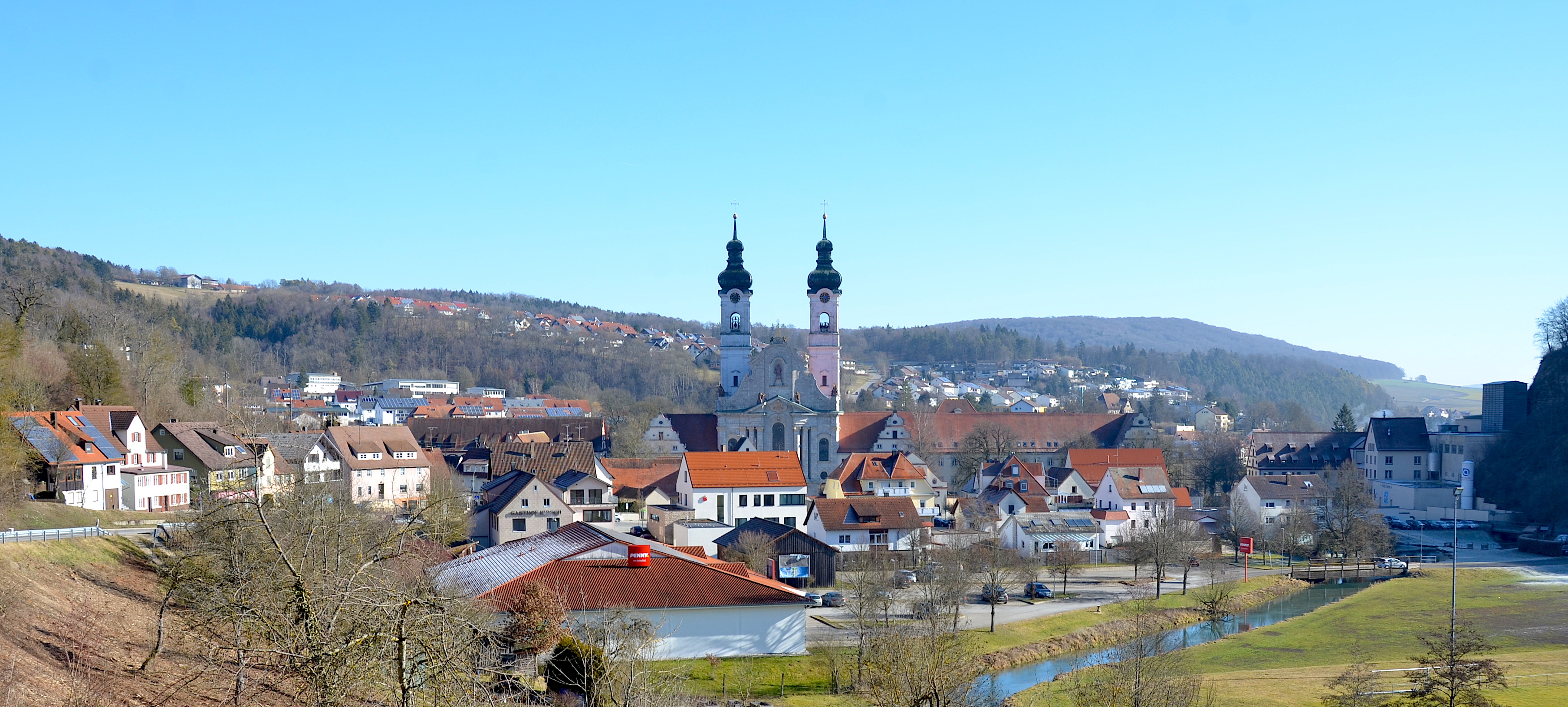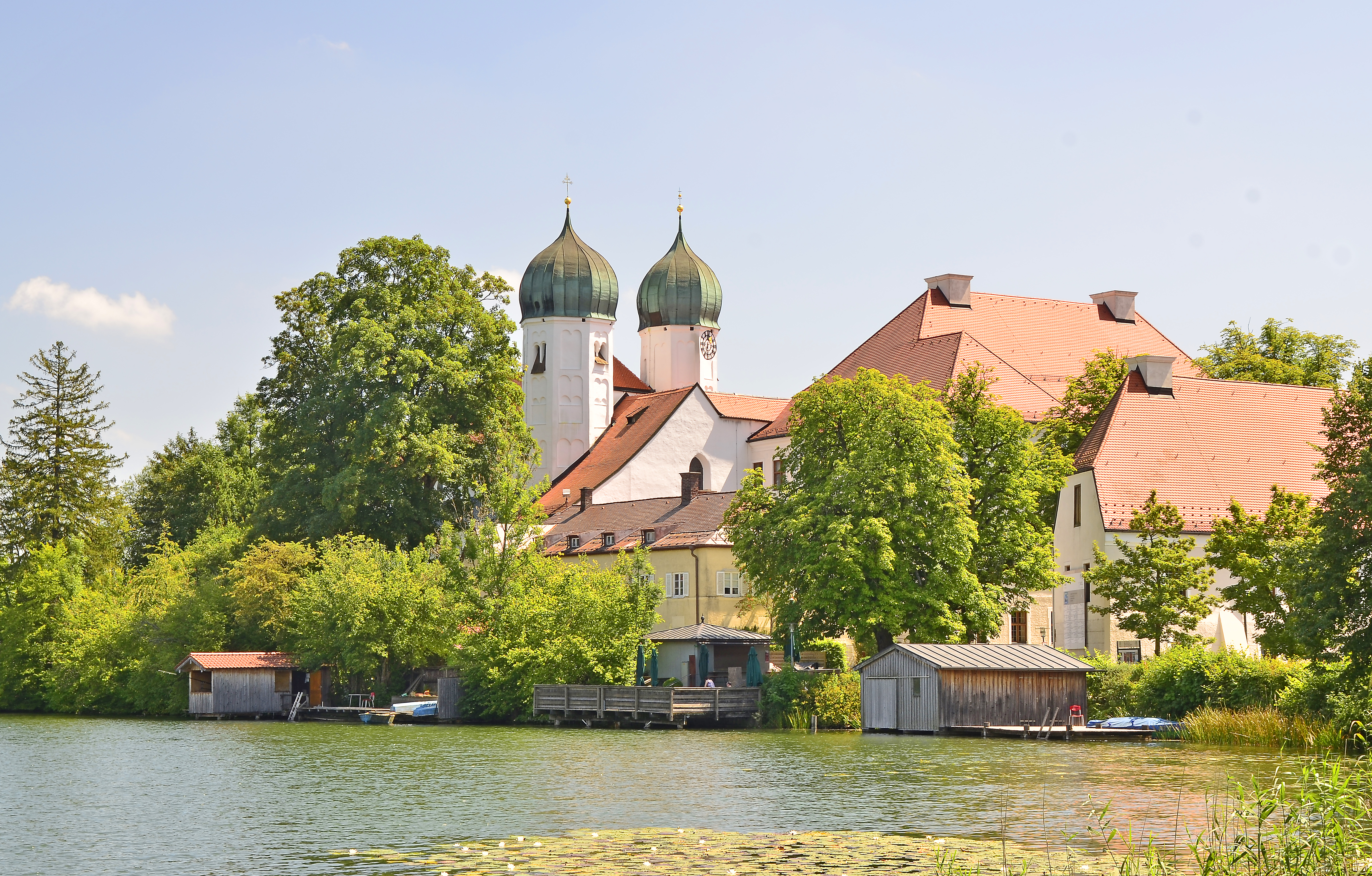|
Johann Michael Feuchtmayer
Johann Michael Feuchtmayer (the Younger) (sometimes spelled Johann Michael Feuchtmayr or Feichtmayr) (1709 – June 4, 1772) was a German stuccoworker and sculptor of the late Baroque period. He collaborated with the architects Johann Michael Fischer, Johann Joseph Christian, and Franz Joseph Spiegler on numerous ecclesiastical buildings in Upper Swabia. His stucco decoration in the Benedictine abbey church (designed by Fischer) of Ottobeuren is considered his crowning achievement.''Germany: A Phaidon Cultural Guide,'' p. 584. Feuchtmayer was born into a family of artists in Wessobrunn, Bavaria. He and his uncle, the stuccoworker Franz Joseph Feuchtmayer (1660–1718); his uncle, the painter Johann Michael Feuchtmayer the Elder, Johann Michael Feuchtmayer the Elder (1666–1713); his brother Franz Xaver Feuchtmayer the Elder (1705–1764); his cousin, the painter and sculptor Joseph Anton Feuchtmayer (1696–1770); and his nephew, Franz Xaver Feuchtmayer the Younger ... [...More Info...] [...Related Items...] OR: [Wikipedia] [Google] [Baidu] |
Haigerloch
Haigerloch is a town in the north-western part of the Swabian Alb in Germany. Geography Geographical location Haigerloch lies at between 430 and 550 metres elevation in the valley of the Eyach river, which forms two loops in a steep shelly limestone valley. The town is therefore also called the 'Felsenstädtchen' (rocky/cliffy small town). Neighbouring municipalities Haigerloch's neighbouring municipalities are specified below in clockwise order from the north, and belong to the Zollernalbkreis unless indicated. Starzach ¹, Rangendingen, Grosselfingen, Balingen, Geislingen, Rosenfeld, Sulz am Neckar ², Empfingen ³ and Horb am Neckar ³. ¹ Landkreis Tübingen, ² Landkreis Rottweil, ³ Landkreis Freudenstadt Districts Haigerloch consists of the following nine districts: * Bad Imnau * Bittelbronn * Gruol * Hart * Haigerloch * Owingen * Stetten * Trillfingen * Weildorf It is located 397 m above sea level. NN and has 572 inhabitants (31 December 2011). Bad Imnau was incorpor ... [...More Info...] [...Related Items...] OR: [Wikipedia] [Google] [Baidu] |
Ottobeuren Abbey
Ottobeuren is a Benedictine abbey, located in Ottobeuren, near Memmingen in the Bavarian Allgäu, Germany. For part of its history Ottobeuren Abbey was one of the 40-odd self-ruling imperial abbeys of the Holy Roman Empire and, as such, was a virtually independent state. At the time of its dissolution in 1802, the imperial abbey covered 266 square kilometers and had about 10,000 subjects. First foundation It was founded in 764 by Blessed Toto, and dedicated to Alexander of Bergamo, St. Alexander, the martyr. Of its early history little is known beyond the fact that Toto, its first abbot, died about 815 and that Ulrich of Augsburg, Saint Ulrich was its abbot in 972. In the 11th century its discipline was on the decline, until Abbot Adalhalm (1082–94) introduced the Hirsau Reform. The same abbot began a restoration of the decaying buildings, which was completed along with the addition of a convent for noble ladies, by his successor, Abbot Rupert I (1102–45). Under the rule of ... [...More Info...] [...Related Items...] OR: [Wikipedia] [Google] [Baidu] |
Ottobeuren
Ottobeuren ( Swabian: ''Ottobeire'', Medieval Latin: ''Ottobura'') is a market town and municipality in Bavaria, Germany, located 11 km southeast of Memmingen near the A7. It is famous for Ottobeuren Abbey, situated next to the Basilica. The town is seat of a municipal association with Hawangen and Böhen. The musicologist Manfred Hermann Schmid was born in Ottobeuren. Twin towns — sister cities Ottobeuren is twinned with: * Norcia, Italy * Saint-Donat-sur-l'Herbasse, France * Tenterfield, New South Wales Tenterfield is a regional town in New South Wales, Australia. At the , Tenterfield had a population of 4,066. Tenterfield's proximity to many regional centres and its position on the route between Sydney and Brisbane led to its development as a ..., Australia References Unterallgäu {{Unterallgäu-geo-stub ... [...More Info...] [...Related Items...] OR: [Wikipedia] [Google] [Baidu] |
Dießen Am Ammersee
Dießen am Ammersee (Southern Bavarian: ''Diaßn am Ammasä'') is a municipality in the district of Landsberg in Bavaria in Germany. It is located on the shores of the Ammersee. Geography Situated in the Bavarian Alpine Foreland the town stretches from the shores of the Ammersee to the forested morainic hills of the Saale and Würm glaciation. The town area consists of the market town A market town is a settlement most common in Europe that obtained by custom or royal charter, in the Middle Ages, a market right, which allowed it to host a regular market; this distinguished it from a village or city. In Britain, small rural ... of Dießen (with St. Georgen, Wengen, Ziegelstadel, Bischofsried and Seehof) and the former independent boroughs of Rieden (with Riederau, Bierdorf, Lachen, St. Alban and Romenthal), Dettenschwang (with Oberhausen, Unterhausen, Wolfgrub and Abtsried), Dettenhofen (with Pitzeshofen, Engenried, Hübschenried and Ummenhausen) and Obermühlhausen (wi ... [...More Info...] [...Related Items...] OR: [Wikipedia] [Google] [Baidu] |
Augsburg
Augsburg (; bar , Augschburg , links=https://en.wikipedia.org/wiki/Swabian_German , label=Swabian German, , ) is a city in Swabia, Bavaria, Germany, around west of Bavarian capital Munich. It is a university town and regional seat of the ''Regierungsbezirk'' Schwaben with an impressive Altstadt (historical city centre). Augsburg is an urban district and home to the institutions of the Landkreis Augsburg. It is the third-largest city in Bavaria (after Munich and Nuremberg) with a population of 300,000 inhabitants, with 885,000 in its metropolitan area. After Neuss, Trier, Cologne and Xanten, Augsburg is one of Germany's oldest cities, founded in 15 BC by the Romans as Augsburg#Early history, Augusta Vindelicorum, named after the Roman emperor Augustus. It was a Free Imperial City from 1276 to 1803 and the home of the patrician (post-Roman Europe), patrician Fugger and Welser families that dominated European banking in the 16th century. According to Behringer, in the sixteen ... [...More Info...] [...Related Items...] OR: [Wikipedia] [Google] [Baidu] |
Amorbach Abbey
Amorbach Abbey (german: Kloster Amorbach) was a Benedictine imperial abbey of the Holy Roman Empire located at Amorbach. It was later the residence of the rulers of the short-lived Principality of Leiningen, before that became part of the Kingdom of Bavaria, and its historic buildings still belong to the princely family. The abbey is now in the district of Miltenberg in Lower Franconia, Bavaria, Germany. History The abbey was one of four Carolingian foundations intended to establish Christianity in the region of the Odenwald, the others being the monasteries of Lorsch, Fulda, and Mosbach). According to legend, a ''Gaugraf'' named Ruthard called the Frankish bishop Saint Pirmin to the area to set up a monastic settlement with chapel west of today's town, at the entrance to the Otterbachtal. A disciple of Pirmin, an Aquitanian called "Amor" is reported to have moved the monastery to its current location in 734. The patrons were the Virgin Mary, with Saints Simplicius, Fau ... [...More Info...] [...Related Items...] OR: [Wikipedia] [Google] [Baidu] |
Amorbach
Amorbach () is a town in the Miltenberg district in the ''Regierungsbezirk'' of Lower Franconia (''Unterfranken'') in Bavaria, Germany, with some 4,000 inhabitants. It is situated on the small river Mud, in the northeastern part of the Odenwald. History The town began as a Benedictine monastery ( Amorbach Abbey or ''Kloster Amorbach''), which bit by bit grew into a settlement until in 1253 it was raised to the status of a town. Over the years, the town changed hands several times. It was part of the Bishopric of Würzburg until 1656, when it became part of the Archbishopric of Mainz. As a result of the 1803 German Mediatisation the Archbishopric of Mainz was secularized, and Amorbach became the residence town of the short-lived Principality of Leiningen. Only in 1816 did it become part of the Kingdom of Bavaria. In 1965, Amorbach attained the status of a climatic spa (''Luftkurort''). Amalgamations The following settlements have been amalgamated with the town: * 1 April ... [...More Info...] [...Related Items...] OR: [Wikipedia] [Google] [Baidu] |
Zwiefalten Abbey
Zwiefalten Abbey (german: Kloster Zwiefalten, Abtei Zwiefalten or after 1750, ) is a former Benedictine monastery situated at Zwiefalten near Reutlingen in Baden-Württemberg in Germany. History The monastery was founded in 1089 at the time of the Investiture Controversy by Counts Gero and Kuno of Achalm, advised by Bishop Adalbero of Würzburg and Abbot William of Hirsau. The first monks were also from Hirsau Abbey, home of the Hirsau Reforms (under the influence of the Cluniac reforms), which strongly influenced the new foundation. Noker von Zwiefalten was the first abbot and led from 1065–90. The monk Ortlieb wrote a history of the monastery in the early 12th century. Berthold continued it to 1137–38. He served as abbot in 1139–1141, 1146/7–1152/6 and 1158–1169. During the 12th century Saint Ernest (died 1148) was abbot. Between 1145 and 1149 he participated in the Second Crusade to regain the Holy Lands including Jerusalem. Although Pope Urban VI granted spec ... [...More Info...] [...Related Items...] OR: [Wikipedia] [Google] [Baidu] |
Zwiefalten
Zwiefalten is a municipality in the district of Reutlingen, Baden-Württemberg, Germany located halfway between Stuttgart and Lake Constance. The former Zwiefalten Abbey dominates the town. The former monastery is considered one of the finest examples of late Baroque art. Geographical location The name derives from its location in the valleys of Zwiefalter Aach and the Kessel-Aach and was mentioned first as Zwivaltum in 904. Neighboring communities The following cities and towns are bordering to the municipality of Zwiefalten (listed clockwise from the north) and belong to the district of Reutlingen and the Alb-Donau-district¹ and district Biberach²: Hayingen, Emeringen¹, Riedlingen², Langenenslingen² and Pfronstetten. Municipality arrangement The municipality Zwiefalten with the municipality parts Baach, Gauingen, Gossenzungen, Hochberg, Mörsingen, Sonderbuch, and Upflamör Zwiefalten include a total of seven villages, one hamlet (Attenhöfen) and three yards (Loretto, ... [...More Info...] [...Related Items...] OR: [Wikipedia] [Google] [Baidu] |
Sigmaringen
Sigmaringen (Swabian German, Swabian: ''Semmerenga'') is a town in southern Germany, in the state of Baden-Württemberg. Situated on the upper Danube, it is the capital of the Sigmaringen (district), Sigmaringen district. Sigmaringen is renowned for its castle, Schloss Sigmaringen, which was the seat of the principality of Hohenzollern-Sigmaringen until 1850 and is still owned by the Hohenzollern family. Geography Sigmaringen lies in the Danube valley, surrounded by wooded hills south of the Swabian Alb and around 40 km north of Lake Constance. The surrounding towns are Winterlingen (in the district of Zollernalb) and Veringenstadt in the north, Bingen, Baden-Württemberg, Bingen, Sigmaringendorf, and Scheer, Germany, Scheer in the east, Mengen, Germany, Mengen, Krauchenwies, Inzigkofen, and Meßkirch in the south, and Leibertingen, Beuron, and Stetten am kalten Markt in the west. The town is made up of the following districts: Sigmaringen town center, Gutenstein (Sigmarin ... [...More Info...] [...Related Items...] OR: [Wikipedia] [Google] [Baidu] |
Seeon Abbey
Seeon Abbey (german: Kloster Seeon) is a former Benedictine monastery in the municipality of Seeon-Seebruck in the rural district of Traunstein in Bavaria, Germany. History Seeon Abbey was founded in 994 by the Bavarian ''Pfalzgraf'' Aribo I, a member of the Aribonid dynasty, and settled by Benedictine monks from St. Emmeram's Abbey in Regensburg. The monastery is on an island in the lake '' Seeoner See'', part of the present-day municipality of Seeon-Seebruck. The abbey soon developed a significant scriptorium, producing manuscripts not only for the abbey's own use but also for other monasteries and churches. Their most important client was Emperor Henry II, who presented many volumes to the Bishopric of Bamberg, which he had founded in 1007. Toward the end of the 11th century the abbey church was re-built in the Romanesque style, but this building stood for only 100 years or so, before in about 1180 it was replaced by the present church, terminating in the east with an ap ... [...More Info...] [...Related Items...] OR: [Wikipedia] [Google] [Baidu] |






